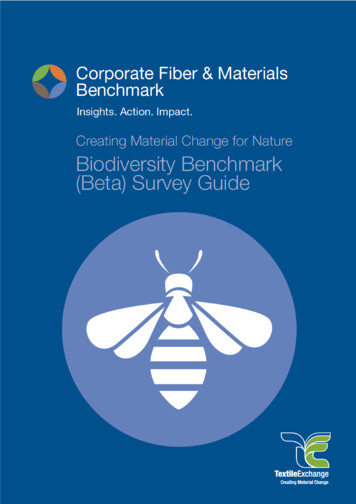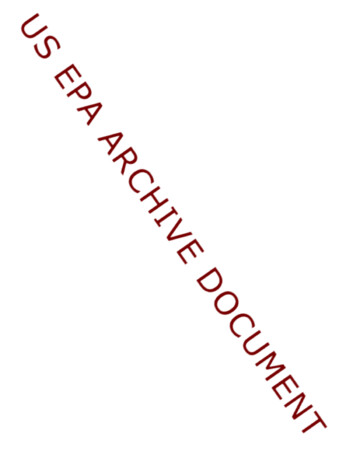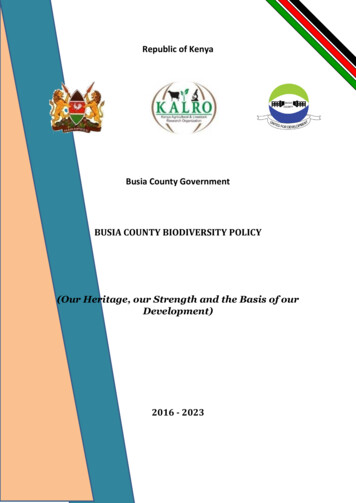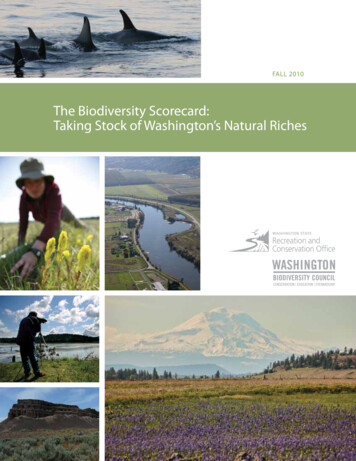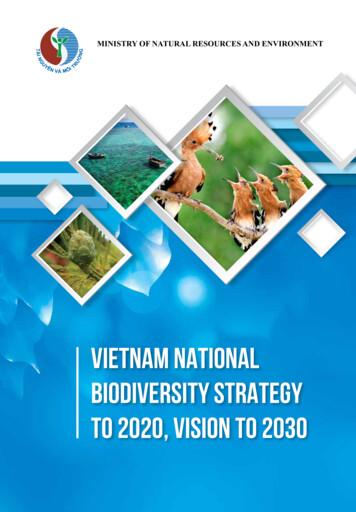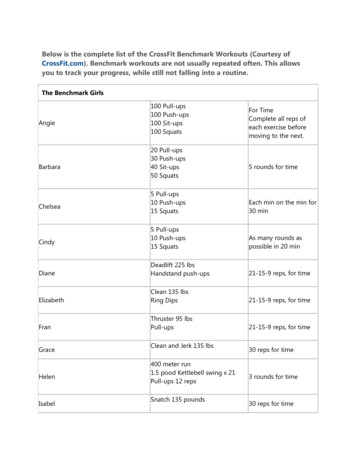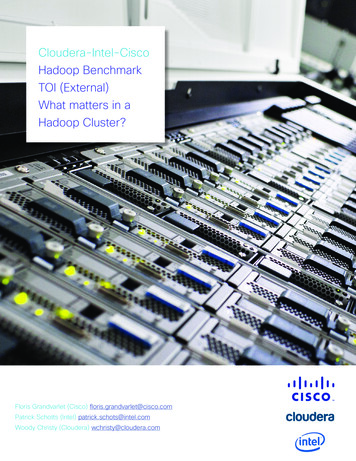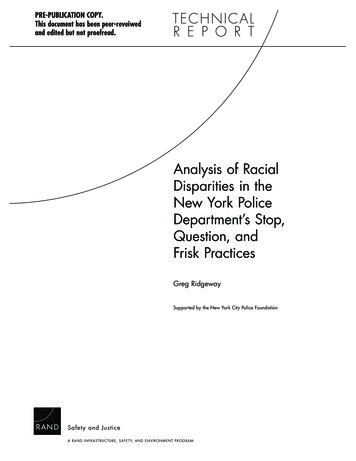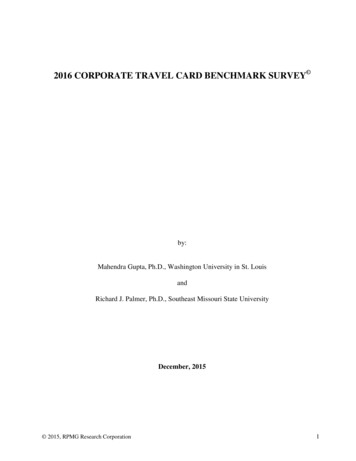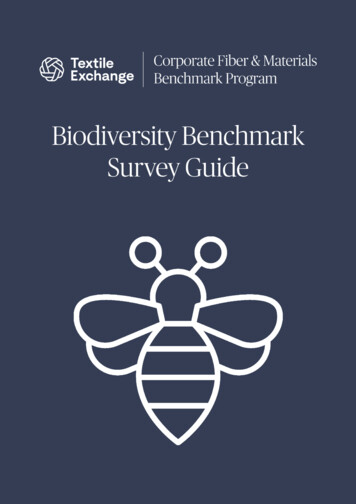
Transcription
Biodiversity Benchmark Survey GuideFor support contact CFMB@TextileExchange.orgTextile Exchange 20221
The Biodiversity Benchmark and following guidance have been developed by Textile Exchangein partnership with The Biodiversity Consultancy, and Conservation International. Madepossible by the generous support of Sappi Ltd.Biodiversity Benchmark Survey GuideFor support contact CFMB@TextileExchange.orgTextile Exchange 20222
Table of ContentsWhy Biodiversity, Why Now? . 5Textile Exchange’s Approach to Biodiversity . 7Part I: The Biodiversity Benchmark . 9Biodiversity Benchmark framework . 10How to use this Survey Guide . 11Evidence and supporting documentation. 11Section I: Business Integration . 12S-1. Corporate Strategy. 12S-2. Leadership . 24S-3. Internal Engagement. 25S-4. Materiality . 27S-6. Investment . 34S-7. Reporting. 37Section II: Materials Portfolio (Transparency) . 40Section III: Biodiversity Impact Area . 45BI-0. Perspectives . 45BI-1. Implementation . 46BI-2. Monitoring and Evaluation . 59Part II: Appendix . 63Glossary . 63Appendix 1: Key Terms and Definitions . 65Appendix 2: Key Initiatives . 75Biodiversity Benchmark Survey GuideFor support contact CFMB@TextileExchange.orgTextile Exchange 20223
The Biodiversity Benchmark Survey Guide provides pragmatic guidance to help companies complete the survey.While a company’s biodiversity strategy is being fully developed and science-based targets confirmed, weadvocate for a “no regrets” approach to action. The no-regrets approach (defined by the UNDP, UNEP, and IUCNand expressed by the Science Based Targets Network) focuses on maximizing positive and minimizing negativeaspects of nature-based adaptation strategies and options. No-regret actions include [ ] measures taken whichdo not worsen vulnerabilities [e.g., to climate change] or which increase adaptive capacities and measures thatwill always have a positive impact on livelihoods and ecosystems [e.g., regardless of how the climate changes].Textile Exchange is a member of the Science Based Targets Network Corporate Engagement Program.Recommended citation: Textile Exchange and The Biodiversity Consultancy (2022) Corporate Fiber & MaterialsBenchmark: Creating Material Change for Nature, Biodiversity BenchmarkBiodiversity Benchmark Survey GuideFor support contact CFMB@TextileExchange.orgTextile Exchange 20224
Why Biodiversity, Why Now?“It is the sourcing of raw materials that is the direct interface betweenbusiness and nature. Through sustainable sourcing and reconfiguringsupply chains, we can help drive change in agriculture, mining, andforestry, and promote regenerative, wildlife-friendly approaches toproduction.”– Dr. Helen Crowley, Partner, PollinationBiodiversity – the fabric of life created by genes, species and ecosystems and all their complex interactions – isbeing lost at an alarming pace.The links between the COVID-19 outbreak and biodiversity loss are clear (Nature). Increasing habitatfragmentation, land use change, and wildlife exploitation globally are exacerbating risks for both globalbiodiversity and human health. Tragically, at the time of writing, the COVID-19 pandemic has resulted in over 6.3million deaths and 535.8 million cases worldwide (WHO). This has resulted in increased calls for a One Healthapproach to disease prevention, which recognizes the interconnection between the health of people, animals,plants, and their shared environment (CDC). Disease emergence, natural disasters, food insecurity, and otherincreasing threats have driven the issue of biodiversity loss higher up the political, business, and societal agenda.In 2019, the scientific community released its latest report (IPBES Global Assessment) on the status of speciesand ecosystems. The report found that around 1 million animal and plant species are now threatened withextinction, many becoming threatened within decades, more than ever before in human history. These dramaticresults highlight what the Stockholm Resilience Center has also shown in relation to planetary boundaries: weare beyond the safe operating space for humanity when it comes to the degradation of our biosphere. TheWorld Economic Forum (WEF) positions nature loss as one of the greatest systemic risks to the global economyand the health of people and the planet.The time is right to do something about biodiversity.The Dasgupta Review released its full report earlier this year. This independent, global review on the Economicsof Biodiversity is led by Professor Sir Partha Dasgupta (Frank Ramsey Professor Emeritus, University ofCambridge). The Review was commissioned by the UK Government and is positioned to do for biodiversity whatthe Stern Review did for climate change in emphasizing that the benefits of strong, early action outweigh thecosts.“As we entered the Decade of Action to deliver the UN SustainableDevelopment Goals, expectations were high that we would see stridestowards a consensus that places nature at the heart of the conversationaround the climate emergency.”– The World Economic ForumThe year 2020 was coined the “super year” for nature by the United Nations Environment Program, amongmany others. The United Nations Summit on Biodiversity was held in September 2020; in response, 64 worldleaders (and counting) from 5 continents have signed the Leaders’ Pledge for Nature, committing to placewildlife and the climate at the heart of post-pandemic economic recovery plans, addressing the climate crisis,deforestation, ecosystem degradation, and pollution.The 15th Conference of Parties (COP) of the Convention on Biological Diversity (CBD) was to be held in Kunming,China, in October 2020. There are 196 Parties to the CBD as of November 2020. COP 15 has been rescheduledfor the third quarter of 2022, at which time the Parties will review the achievements and delivery of the CBD’sBiodiversity Benchmark Survey GuideFor support contact CFMB@TextileExchange.orgTextile Exchange 20225
Strategic Plan for Biodiversity 2011-2020 and are expected to finalize the post-2020 global biodiversityframework.Biodiversity is also an integral component of the Sustainable Development Goals (SDGs) 2030 Agenda forSustainable Development, which are a universal call to promote prosperity while protecting the planet. WhileGoal 14 “Life Below Water” and Goal 15 “Life on Land” address biodiversity most directly, it is also immediatelyrelevant to many other SDGs, socio-economic and environmental alike (IISD 2019). The 2030 Agenda forSustainable Development was adopted by all United Nations Member States in 2015.At this stage, the focus on biodiversity risks in the textile industry – as with many others - is nascent.Apparel and textile companies are gearing for action and Textile Exchange can help. Textile Exchange membersare starting to set goals and the Fashion Pact has attracted 70 plus signatories representing over 200 brands tomake a biodiversity commitment and set targets in alignment with the Science Based Targets for Nature.Linking Biodiversity and Climate“There is no climate solution without the full contribution from nature. Ifwe are able to realize the full contribution of nature to climate changemitigation, we will have also achieved the goal of biodiversityconservation.”– Inger Andersen, Executive Director, United Nations Environment ProgrammeThreats to biodiversity and major contributors to the climate crisis are often one and the same. Greenhouse gasemissions from agriculture, forestry, and other land use represent 23 percent of total anthropogenic emissions(IPCC 2019). Deforestation alone is a major source of global emissions.Natural ecosystems provide benefits that address climate change, such as carbon sequestration, regulation oflocal climate air quality, and moderation of extreme natural events. Conservation International estimates thatover 30 percent of cost-effective solutions for climate change are grounded in nature. Natural Climate Solutions(NCS) are a form of Nature-based Solution (as defined by the IUCN) that allow for the capture of carbon throughconservation, ecosystem restoration, and improved land management across global forests, wetlands,grasslands, and agricultural lands. These very same climate actions will also protect the richness and diversity ofnative wild plants and animals and the habitats on which they depend.In turn, the protection of biodiversity enables the healthy functioning of nature’s contributions to people (i.e.,ecosystem services): ecological processes which make human life possible (FAO). Biodiversity plays a key role inbenefits such as pollination, erosion prevention, waste-water treatment, biological control of pests and disease,and preventing species extinction, among other natural, economic, health, and cultural benefits. Biodiversityalso helps to protect genetic diversity and the availability of raw materials. Combined, the stock of naturalresources that provide these contributions to society are also known as natural capital.“Since the nature and climate crises are deeply intertwined, we musttackle both simultaneously. By setting science-based targets for climateand nature, companies and cities can generate multiple benefits. Theseinclude mitigating climate change through increasing carbonsequestration as well as helping stabilizing nature which is the source ofthe food, fiber and fuel human activities depend on.”– The Science Based Targets NetworkBiodiversity Benchmark Survey GuideFor support contact CFMB@TextileExchange.orgTextile Exchange 20226
The good news is that there is a great deal that we can do to address climate change effectively by taking actionsin three key areas: decarbonization, nature-based/natural climate solutions, and the transition to a circulareconomy. Each of these areas also enables us to protect biodiversity as irreplaceable natural capital andprovides an opportunity to halt the current extinction crisis.Textile Exchange’s Approach to BiodiversityTextile Exchange’s Climate Strategy recognizes that climate change and biodiversity loss are inextricably linkedand are best considered within an integrated strategy. Textile Exchange’s strategic intent is to be a driving forcefor urgent climate action in textile fiber and materials production, specifically through: Enabling and guiding the textile industry to reduce greenhouse gas emissions by 45 percent by 2030 inthe pre-spinning phase of textile fiber and materials production.Amplifying positive impacts in soil health, water, and biodiversity.Prioritizing nature in fiber and materials management and sourcing decisions will bring long-term businessbenefits, more resilient livelihoods, health and wellbeing for communities, and safer interfaces between wildand managed lands and species. For this to happen, it will require a heightened focus on designing andimplementing biodiversity-sensitive raw materials strategies that drive positive action, outcomes and impactsthat can ultimately be tracked and measured.Biodiversity Benchmark Survey GuideFor support contact CFMB@TextileExchange.orgTextile Exchange 20227
Holistic change modelFigure 1: A holistic approach to transforming materials use, addressing climate change, biodiversity loss and delivering on the SDGs andassuring a just transition for all, Textile ExchangeFigure 1 notes:Decarbonization refers to the process of reducing “carbon intensity,” lowering the amount of greenhouse gasemissions [produced by the burning of fossil fuels] (IPCC). Nature-based Solutions are actions to protect,sustainably manage, and restore natural and modified ecosystems that address societal challenges effectivelyand adaptively, simultaneously providing human well-being and biodiversity benefits (IUCN). Natural ClimateSolutions are concerned with capturing carbon through conservation, ecosystem restoration and improved landmanagement across global forests, wetlands, grasslands and agricultural lands (CI). A Circular Economy is basedon the principles of designing out waste and pollution, keeping products and materials in use, and regeneratingnatural systems (EMF). Sustainable Development Goals (SDGs): 2020 ushered in a decade of ambitious action todeliver the 17 Goals by 2030 – assuring a “just transition” that leaves no one behind. This “Decade of Action”calls for accelerated sustainable solutions to the world's biggest challenges — ranging from poverty and genderto climate change, inequality and closing the finance gap (United Nations).Biodiversity Benchmark Survey GuideFor support contact CFMB@TextileExchange.orgTextile Exchange 20228
Part I: The Biodiversity BenchmarkAccording to the World Benchmarking Alliance (WBA), benchmarking drives a “race to the top” and is one of theways Textile Exchange (an ally of the WBA) mobilizes the industry to accelerate the uptake of preferredmaterials. Through Textile Exchange’s Corporate Fiber & Materials Benchmark (CFMB) program and its annuallypublished Material Change Index (MCI), participating companies are already making significant headway inidentifying their portfolio of materials, the sustainability programs they are investing in, and targets for uptakeand improvement, including Science Based Targets. The CFMB program also helps companies calculate uptake ofpreferred fibers and materials and report the extent to which materials are mapped back to the country oforigin. This work forms the bedrock for understanding biodiversity risks and building a strategy to limit negativeimpacts from the company’s supply base.The Biodiversity Benchmark has been developed in partnership with Conservation International, The BiodiversityConsultancy, and reviewed by a broad multi-stakeholder advisory group. The survey content builds on thereporting framework, themes, and elements of the MCI survey.The role of the Biodiversity Benchmark is to help companies track how they understand biodiversity risk in theirraw materials supply base and how they are addressing these risks through credible, good practice strategies.Our ambition is to help prepare the textile industry for urgent action on this important cross-cutting topic. TheBenchmark is designed to help companies compare performance to fundamental elements of good practicebiodiversity risk management. Practitioners can use the Biodiversity Benchmark to understand the direction oftravel their company needs to commit to and implement in order to become nature positive by 2030. TheBenchmark guidance provides practical knowledge and insights on biodiversity risks, relevance to the appareland textile industry, and how these risks can best be managed.The methodology for companies to set targets and track their contribution to the global goals for nature is beingdeveloped now through the Science Based Targets Network (SBTN). This Biodiversity Benchmark will developalongside the Science Based Targets for Nature and we will work closely with the SBTN on consistency inlanguage, frameworks, and measurements to support our benchmarking participants on their biodiversityjourney. Use of this Benchmark - and its future iterations - will help companies prepare for stakeholder(including investor) questions around nature-related risk, such as those being developed by the Task Force onNature-related Financial Disclosures (TNFD), CDP, and Ceres. The Benchmark will also help companies in meetingthe Sustainable Development Goals (SDGs).The Biodiversity Benchmark was piloted in 2021 to establish a baseline of the engagement and effort thatcompanies are starting to put into biodiversity. The findings from this first cycle were published as the first-everBiodiversity Insights Report for the apparel and textile industry, helping us formulate where we should beheading and to appreciate what best practice looks like today.Textile Exchange would like to thank the following individuals who contributed to the revision of the BiodiversityBenchmark survey and guidance content in preparation for the 2022 cycle: Peter Burston, Tami Putri, and KatieFensome, The Biodiversity Consultancy; Katie Russell, Franklin Holley, and Margot Wood, ConservationInternational; Payal Luthra, Alexis Morgan, and Rebekah Church, WWF; and Hanna Denes and Anna Heaton,Textile Exchange.Finally, Textile Exchange is an ally of the World Benchmarking Alliance (WBA). WBA Allies representorganizations working at global, regional, and local levels to shape the private sector’s contributions to achievingthe Sustainable Development Goals (SDGs). Echoing the true spirit of SDG17 – Partnerships for the Goals, WBAAllies are committed to WBA’s mission, vision, and values, and believe in the power of benchmarks and crosssector partnerships to drive systemic progress on the SDGs. The Biodiversity Benchmark will contributesignificantly to corporate exchanges and learning opportunities.Biodiversity Benchmark Survey GuideFor support contact CFMB@TextileExchange.orgTextile Exchange 20229
Biodiversity Benchmark frameworkFollowing its inaugural cycle, the Biodiversity Benchmark was integrated into the MCI survey framework andreporting cycle as an optional Impact Area. Biodiversity questions are now nested within Business Integration,the Materials Portfolios (Transparency), and the Biodiversity Impact Area section, and will become visible forthose who opt-in to this survey. Companies can complete the Biodiversity Impact Area alongside the MaterialsBalance Sheet if they do not wish to participate in the full MCI.The Biodiversity Benchmark is now integrated within three sections of the MCI survey framework: BusinessIntegration, Materials Portfolio, and Impact Area.Figure 2: The Biodiversity Benchmark framework, Textile ExchangeSection I is Business Integration, which starts with how a company is integrating biodiversity into businessstrategy and operations, setting targets, and aligning with the Sustainable Development Goals (SDGs). Nextcomes materiality, incorporating biodiversity risk assessment and the important role of stakeholderengagement. This section also evaluates accountability and internal engagement on biodiversity within theorganization. It includes investments, including those that are biodiversity related. Section I concludes with anassessment on reporting, steering companies towards publicly disclosing their biodiversity risks andopportunities, activities underway, and progress on efforts to mitigate those risks.Section II is Materials Portfolio. Biodiversity Benchmark participants will be required to, at minimum, completethe Materials Balance Sheet, which guides companies in documenting materials uptake. As transparency ofsourcing locations is so crucial in ensuring positive outcomes for biodiversity, knowledge of country of origin isassessed within the Transparency sections of a company’s selected preferred materials. Then, respondents areasked to report on the mapping of sourcing locations against the biodiversity value of the location. This step iscritical to making good intervention decisions, prioritizing, and designing actions.Section III is the Biodiversity Impact Area, drawing on the AR3T Action Framework as outlined by the ScienceBased Targets Network to review actions to mitigate biodiversity risks within supply networks. The Benchmarkconcludes with monitoring and impact improvement, as those actions are crucial measuring progress towardsexpected outcomes and targets.Biodiversity Benchmark Survey GuideFor support contact CFMB@TextileExchange.orgTextile Exchange 202210
How to use this Survey GuideThe questions in this guide are those that are made available to participants who opt-in to the BiodiversityImpact Area. Respondents completing the full MCI, or the full Business Integration Module, will see thesequestions nested alongside the questions enabled through those surveys.Throughout this document, guidance has been provided to help you answer each question. Information hasbeen presented in the following ways.Why this is important: Provides a brief overview of the relevance of the question to the topic or theme coveredin the MCI.What this question is looking for: Where necessary, question specifications are provided to support yourunderstanding of the question and what is required.Definitions: For most questions, definitions or short descriptions of important themes have been provided.Additional reading: Here we provide links to recommended reading and a selection of some of the manyimportant documents available. We attempt to refresh this reference list annually.For more information on question structure, etc. please refer to the CFMB Portal Users Guide.Evidence and supporting documentationProviding supporting evidence is key to a strong survey submission. The quality of your evidence and signpostingto specific information, e.g., in documents and on websites, significantly helps the CFMB team during thevalidation phase and can cut down the number of queries returned to you during this phase. The below listprovides examples of how to submit evidence:Summary/excerpts: Each question has a comment box where you can directly enter short paragraphs of text.Depending on the context, text can be freehand explanations or copy-paste from specific reports/website (withlinks and page numbers provided) to help the validation team quickly locate information.Document uploads: Reports in pdf format, data in excel or other commonly used/easy to access formats, arewelcome. The validation team would be grateful for any signposting (such as page numbers) to help the teamquickly locate information.Links to webpages: Providing links to webpages can be a quick and efficient way for you to back up your answer.It also proves that information is in the public domain, which demonstrates credibility and transparency.Important note on providing evidence: If one document is the reference source for multiple questions, it isperfectly acceptable to refer us to the same document. As mentioned earlier, the validation team welcomes anyadditional signposting such as page numbers to guide validators directly to the specific text or data.Biodiversity Benchmark Survey GuideFor support contact CFMB@TextileExchange.orgTextile Exchange 202211
Section I: Business IntegrationS-1 Strategy S-2 Leadership S-3 Internal Engagement S-4 Materiality S-6 InvestmentS-7 ReportingThe first sections of the Biodiversity Benchmark are embedded in the Business Integration section.S-1. Corporate StrategyS-1a. Sustainability StrategyWhy this is importantA strategy to address biodiversity risk (impact and dependencies) is an indicator of how seriously a companytakes the issue of biodiversity loss and the opportunity to make a positive contribution to this global crisis.Strategic planning is important because it provides direction and supports day-to-day decision making. Astrategy includes longer-term goals, responsibilities, timelines and resource allocation. Importantly, abiodiversity strategy should align with the United Nations Sustainable Development Goals (SDGs).Committing your company to the SDG agenda is an excellent first step and, if your company has a maturesustainability strategy, it may not be difficult to find alignment between your business goals and the SDGs. Thenext step is to prioritize Goals and alight on SDG targets and performance indicators to help you track progressover the coming years. There are challenges and gaps for companies to overcome. First, the targets were initiallydeveloped to facilitate country-level progress reporting and, secondly, there is no industry framework forreporting (and, therefore, a lack of consistency in the way companies measure and report on progress). Wehope the CFMB will help close these gaps for the textile sector.What this question is looking forTo understand whether your company has established a corporate biodiversity strategy, and any enablers,barriers, and/or challenges that it has identified in relation to developing and implementing such a strategy.Companies are asked to indicate whether they have prioritized specific SDGs, and (within each SDG) haveidentified specific targets for measuring progress. Further information regarding the United Nations GlobalCompact and the SDGs can be found here. A list of all 169 targets for the 17 Goals can be accessed here. Pleasealso refer to our SDG Companion Guide.S-1a-2. Does your company have a biodiversity strategy? NoUnder developmentYes, we have a biodiversity strategyYes, and our biodiversity strategy is integrated into our overall corporate strategyYes, biodiversity is integrated, and we are aligning our strategy with the Sustainable Development GoalsS-1a-2a. Is your company’s biodiversity strategy internal or public? Internal PublicBiodiversity Benchmark Survey GuideFor support contact CFMB@TextileExchange.orgTextile Exchange 202212
S-1a-2b. Do you see any barriers/challenges or enablers to developing a biodiversitystrategy? No Barriers/challengesPlease provide details. EnablersPlease provide details.S-1a-3. Is your company measuring its progress towards the SDGs?Please provide details to support your answer in S-1a-3a. NoWe have identified where our company’s priorities lie with respect to one or more SDGsWe have set targets and indicators with respect to one or more of the SDGsWe are tracking the (expected) outcomes and impacts of our company’s activities related to the SDGsS-1a-3a. Our company has prioritized and is progressing the following SDGs.Please provide details to support your answer in S-1a-3a.SustainableDevelopmentGoalsPrioritySDGSet oolDownMMCFPolyesterPolyamideLeatherMaterialsGoal 1: No povertyGoal 2: ZerohungerGoal 3: Goodhealth and wellbeingGoal 4: QualityeducationGoal 5: GenderequalityGoal 6: Cleanwater andsanitationGoal 7: Affordableand clean energyGoal 8: Decentwork andeconomic growthBiodiversity Benchmark Survey GuideFor support contact CFMB@TextileExchange.orgTextile Exchange 202213
Goal 9: Industry,innovation andinfrastructureGoal 10: ReducedInequalityGoal 11:Sustainable citiesand communitiesGoal 12:Responsibleconsumption andproductionGoal 13: ClimateactionGoal 14: Life belowwaterGoal 15: Life onlandGoal 16: Peace andjustice, stronginstitutionsGoal 17:Partnerships forthe GoalsPlease provide an example of your SDG targets and/or further clarification and weblink as supporting evidenceBiodiversity Benchmark Survey GuideFor support contact CFMB@TextileExchange.orgTextile Exchange 202214
DefinitionsBiodiversity strategy: A plan of action designed to achieve biodiversity objectives and commitments. Thestrategy sets the objectives, scope, timeline, responsibilities, and resources to ensure that change is made.Barriers/Challenges: lack of internal enabling condition or factor to allow corporate action on biodiversity totake place, such as lack of internal capacity or lack of management support.Enablers: Internal or external (to the company) factor that enables acceleration or rapid transition for acompany to take action on biodiversity, for example, internal dedicated funding made available for corporatebiodiversity actions or dedicated human resources (e.g., internal taskforce) to accelerate company’s action onbiodiversity.Material: A textile material is a specific substance which is used to make textiles. A material is either a fiberwhich is transformed into yarn or a “non-fiber” material. “Material” is used as an overarching term for bothfiber and non-fiber raw materials.Materials sustainability strategy: There are many ways companies can build a sustainability (includingmaterials sourcing) strategy – and not one size fits all. A company may – or may not – have integrated abiodiversity strategy into other strategic plans.In
The Biodiversity Benchmark Survey Guide provides pragmatic guidance to help companies complete the survey. While a companys biodiversity strategy is being fully developed and science-based targets confirmed, we
